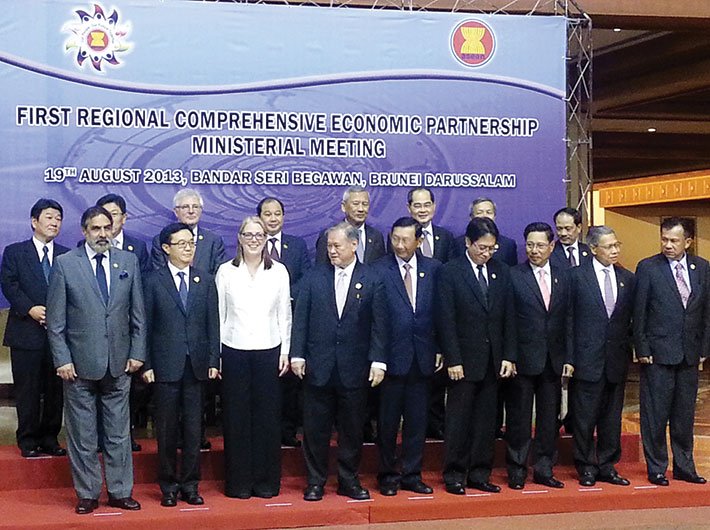As 16 nations gather for 10th round of talks for RCEP, a look at what New Delhi stands to gain
In the present era of slowing aggregate demand and increasing market uncertainties, regional economic cooperation among countries provide some sort of relief to them. Currently, there are three mega ‘regionals’ under negotiation: the Regional Comprehensive Economic Partnership of the Asia and the Pacific (RCEP), the Trans-Pacific Partnership (TPP) and the Trans-Atlantic Trade and Investment Partnership (TTIP).
The RCEP is a free trade agreement (FTA) negotiation between the ten members of the Association of Southeast Asian Nations (ASEAN) and the six nations with which ASEAN has existing FTAs – Australia, China, Japan, Korea, New Zealand and India. RCEP negotiations were launched on the margins of the East Asia Summit on November 20, 2012 by the leaders of these 16 nations. The first round of negotiations took place during May 9-13, 2013 in Brunei. Till date there have been nine rounds of negotiations with New Delhi playing host for the sixth round. The negotiations are to be concluded by the end of 2015 but the deadline for resolving a few issues has been extended to the next year. The tenth round of negotiation were held from October 12 to 16, 2015 in Busan, South Korea.
Once it takes shape, the RCEP would be the largest trading bloc in the world. It would cover a wide range of topics under economic and technical cooperation, right from trade in goods and services to investment, IPRs, competitions and so on. The RCEP nations had a combined output of $21.3 trillion in 2013, which was about 30 percent of the world GDP (IMF figures) while the total trade of RCEP economies was estimated at around 27 percent of world trade (WTO 2012 figures). As per the World Investment Report 2014, the RCEP nations accounted for nearly 20 percent of global FDI flows in recent years. In 2013 alone, combined FDI inflows to the 16 negotiating members of RCEP amounted to $343 billion which is 24 percent of total world inflows. Moreover, these nations make up for nearly 50 percent of the world population. All these figures indicate that if these attributes of this trading bloc are properly harnessed, the East Asian region would definitely become the strongest pivot of the global economy in the years to come.
In the Indian context, RCEP is especially important since the country is not a member of the other two important regional blocs, namely, Asia Pacific Economic Cooperation (APEC) and Trans-Pacific Partnership (TPP). There are a few other facts worth noticing in this context. First, over the last decade and half, India’s trade with the RCEP nations has increased. This is an important positive signal towards such integration. Second, the RCEP negotiations would help India reduce its trade costs with the member-nations of the RCEP. At the same time, it will give India access to a large regional market. This is a revisit to India’s ‘Look East’ policy. Third, the RCEP formulation would also lead to an increase in inward and outward FDI, especially export-oriented FDI. With the Indian companies having access to new markets, ample opportunities would be generated for the Indian youth enabling India to become the world’s hub for services.
Though the RCEP negotiations seem like a win-win game for India, the actual scenario is not that simple. RCEP has been criticised for lack of transparency in the context of IPRs and life-saving medicines. In this respect, India had to face a lot of criticism on the domestic front. It is being argued that some member-nations of the RCEP, especially Japan and South Korea, have been pushing for stronger IPR provisions in the trade agreement which, if accepted, would severely impact the affordability of life-saving drugs in the developing countries. This would hamper the overall social and economic development of India. But this issue, it is hoped, is going to be taken care of as assured by the government.
On the foreign front, India faces criticism from the member-nations of RCEP for offering low market openings. India wants to commit to tariff cuts on less than half the goods but other member-nations consider it too little. India does not want to throw open a majority of sectors for countries with whom it does not have FTAs yet, such as China, Australia and New Zealand. India has so far signed FTAs with ASEAN, South Korea, Japan, Singapore and Malaysia and is negotiating pacts with New Zealand and Australia. It has not signed an FTA with China yet to avoid giving greater access to Chinese goods in India fearing the impact on manufacturing industry here.
India’s policies have always been of the ‘middle ground’ and this attribute of the Indian economy has helped it survive through the thick and thin of the global economic turmoil. This “middling through” of India in the trade negotiations will also not prevent it from achieving its goal of becoming one of the prominent players of the world economy. After all, with the growth prospects of India on a high, who would want to miss the Indian market!

